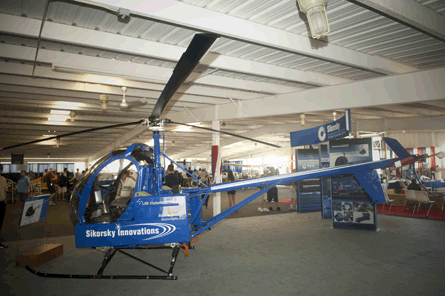Electric propulsion is gaining horsepower within the experimental and light aircraft communities, spearheaded by several new initiatives and research programmes by major airframers and top-tier suppliers.
Consensus among the major players at AirVenture 2010 is that electric batteries and motors with the performance and endurance of traditional small piston engines, without the accompanying noise, vibration and carbon emissions, are within a decade of being realised. In the meantime, several projects are proving the technology and paving the way for what is to come. Most notable at Oshkosh this year were Sikorsky's electrically powered S-300C helicopter, unveiled at the show, and Yuneec's e430 electric light sport aircraft.
Built by Sikorsky and partner companies US Hybrid, Gaia Power Technologies and Eagle Aviation Technologies, the Firefly is expected to fly by year's end. Its 200hp (150kW) Lycoming piston engine has been replaced with an equivalent power electric engine from US Hybrid and instead of fuel tanks there are two 45Ah lithium ion battery packs built by Gaia, one on each side of the cabin. Eagle Aviation performed the modification work.
 |
|---|
© Billypix |
The technology demonstrator will initially have an endurance of 15min with one pilot on board, says Jonathan Hartman, an engineer with Sikorsky's advanced concepts group, called Sikorsky Innovations. Flights are likely to be limited to the traffic pattern, he adds, after initial ground resonance and hover testing flights are completed. In the cockpit, Sikorsky says integrated sensors will provide real-time aircraft health information through a panel integrated interactive LCD monitor.
GE Aviation Systems is pushing the boundaries of more-electric systems with a new collaboration agreement it signed at the show with the University of Dayton. The two will establish an electrical power integrated systems centre "to turn technologies into new products for GE", say officials.
The centre will begin operations in 2012. Initial projects include boosting aircraft power to 270-540V DC systems, primarily for military and transport systems, a development that will allow airframers to reduce the amount, and therefore the weight, of power distribution wiring. Dayton's role in the programme will be to perform modelling and simulation of future electric power systems, with GE verifying the results through testing.
Fixed-wing applications are demonstrably more advanced than Firefly. Shanghai-based aircraft maker Yuneec revealed at AirVenture that it will fly two of its e430 electric aircraft prototypes in formation over the top of the 29,029ft (8,848m) summit of Mt Everest in January or February, drawing attention to the viability of electric-powered flight and Yuneec's designs.
Yuneec displayed its latest iteration of the e430 two-seat, electric-powered aircraft at AirVenture, with several modifications and upgrades from last year's version. Included are removable wingtips to allow the aircraft to fit into a T-hangar; more leg room in the two-place, side-by-side cabin; new Lithium polymer batteries that boost flight time from 1.5h to 2h and an increased battery life of 1,500 cycles, which ideally will equate to 3,000h of flight time. Batteries will take 3h to charge, although Yuneec is developing a 1h charging system that could be used by flight schools for quick turnaround operations.
Pierre Hallet, the company's distributor in France, will fly one of the Everest aircraft. Hallet says the only required modification to the machine is the addition of a variable pitch propeller made by Duc. Hallet says the first e430 production aircraft is to be completed by the end of 2011, with the first delivery to a US customer thereafter.
CHARGE IT
Along with developing batteries for longer duration flights, Yuneec is in discussions with a US company that supplies electrical recharge services at truck stops for recreational vehicles. "We're hoping next year to sell the concept at airports," says Paul Arthy, the UK representative for Yuneec. His "electrical filling station" concept would be credit card based and, based on the recreational vehicle experience, would provide value-added services such as sending a text message when the charge is complete.
"When we hear someone else talking electric, it's brilliant," says Arthy. "It shows its becoming commonplace." He adds it will be five to seven years before a change in battery technology will likely be available to allow for endurance figures similar to today's light aircraft - about 4h.
The Experimental Aircraft Association (EAA) is attempting to accelerate such advances in the experimental builder community with its "eFlight" prize, a $60,000 award to be supplied by four corporate sponsors - Wicks Aircraft Supply, Aircraft Spruce and Specialty, Aeroleds and Dynon Avionics. The team expects to take applications for the award over the coming year, although requirements for winning and the amount on any one prize have not yet been determined.
LSA builder Flight Design is taking an incremental approach to an all-electric aircraft, first developing a hybrid engine that depends on battery power for a boost on take-off and uses the traditional engine to charge the battery. "It's a suitable intermediate step to all-electric flying," says Oliver Reinhardt, chief technology officer for the company.
Reinhardt says today's electric engines have "extremely limited range" because of battery capacity, although the theoretical limits for energy storage leave "a lot of room for development".
He says that within seven to 10 years, battery advances will allow for an all-electric aircraft to have a 3h endurance, carrying two people for 300nm (550km). Like Yuneec, Flight Design is also looking ahead as to how to provide recharge capability for the electric engines. Along with quick charge options, the industry may also consider options like battery swapping.
- All the latest news, video and images from EAA AirVenture Oshkosh 2010
Source: Flight International



















